Counting Small Particles in Electron Microscopy Images—Proposal for Rules and Their Application in Practice
Abstract
:1. Introduction
2. Terms, Definitions and Agglomeration State
2.1. Primary Particles, Individual Particles, Agglomerates and Aggregates
2.2. Sample Preparation
2.3. Agglomeration Cases on the Substrate
- (a)
- An ideally dispersed sample/specimen: A specimen containing only individual particles, separated from each other, which can be counted easily “one-by-one”. The uncertainty for the size distribution pertains to the instrumental resolution and the (subjective) view of the operator.
- (b)
- A predominantly well-dispersed sample/specimen with touching particles: the sample preparation process has led to agglomeration of individual particles on the substrate. If it is known that the sample preparation has resulted in solely individual particles and that agglomeration results only from the preparation of the specimen, the operator can decide which particles are touching and/or overlapping and not completely visible. The uncertainty of the resulting size distribution is greater than in case (a), but in most cases, the counting procedures (a) or (b) will not influence the resulting size distribution.
- (c)
- A predominantly well-dispersed sample/specimen with a few agglomerates: The sample itself contains agglomerates, which could not be separated during the sample preparation process. In this case, it is not possible to distinguish between agglomerates from the sample and touching particles occurring during/after deposition on the substrate. The uncertainty further increases in comparison with case (b). Depending on the choice of rule to identify and count particles, agglomerates and aggregates (by standardisation bodies or from legislation), the particles might be identified and counted differently, possibly leading to significant differences in the resulting size distribution.
- (d)
- A dispersed sample/specimen with agglomerates and aggregates: The specimen contains aggregates and agglomerates predominantly. The distinction between aggregates and agglomerates with electron microscopy is, in most cases, based on assumptions. If no gaps can be identified between the integral components of the agglomerates/aggregates, the particles will probably be identified as aggregates; otherwise, they will be identified as agglomerates. Depending on whether the ISO or regulatory definitions are applied, agglomerates and aggregates might be counted differently, possibly resulting in significantly different size distributions.
- (e)
- A dispersed sample/specimen with agglomerates, aggregates and agglomerates of aggregates: The specimen contains aggregates and agglomerates and agglomerates of aggregates. Depending on whether ISO or regulatory definitions are applied, particle identification and counting might be very different. In practice, the sample preparation needs to be optimised as far as possible, or the counting will be strongly subjective and depend on a combination of sample preparation, used instrument and the operator. This case might result in a specimen/sample that cannot be reliably analysed by EM due to the highly subjective interpretation of the image.
3. Counting Rules
3.1. Counting Only Individual Particles—CR1
3.2. Counting Individual Particles, Agglomerates and Aggregates as One Particle Each—CR2
3.3. Counting Individual and Touching Particles (within Agglomerates) as One Particle—CR3
3.4. Counting of Particles within Agglomerates and Aggregates—CR4
4. Counting of Particles in Practice
4.1. Sample Preparation for Electron Microscopy
4.2. Typical TEM Image with Different Counting Possibilities
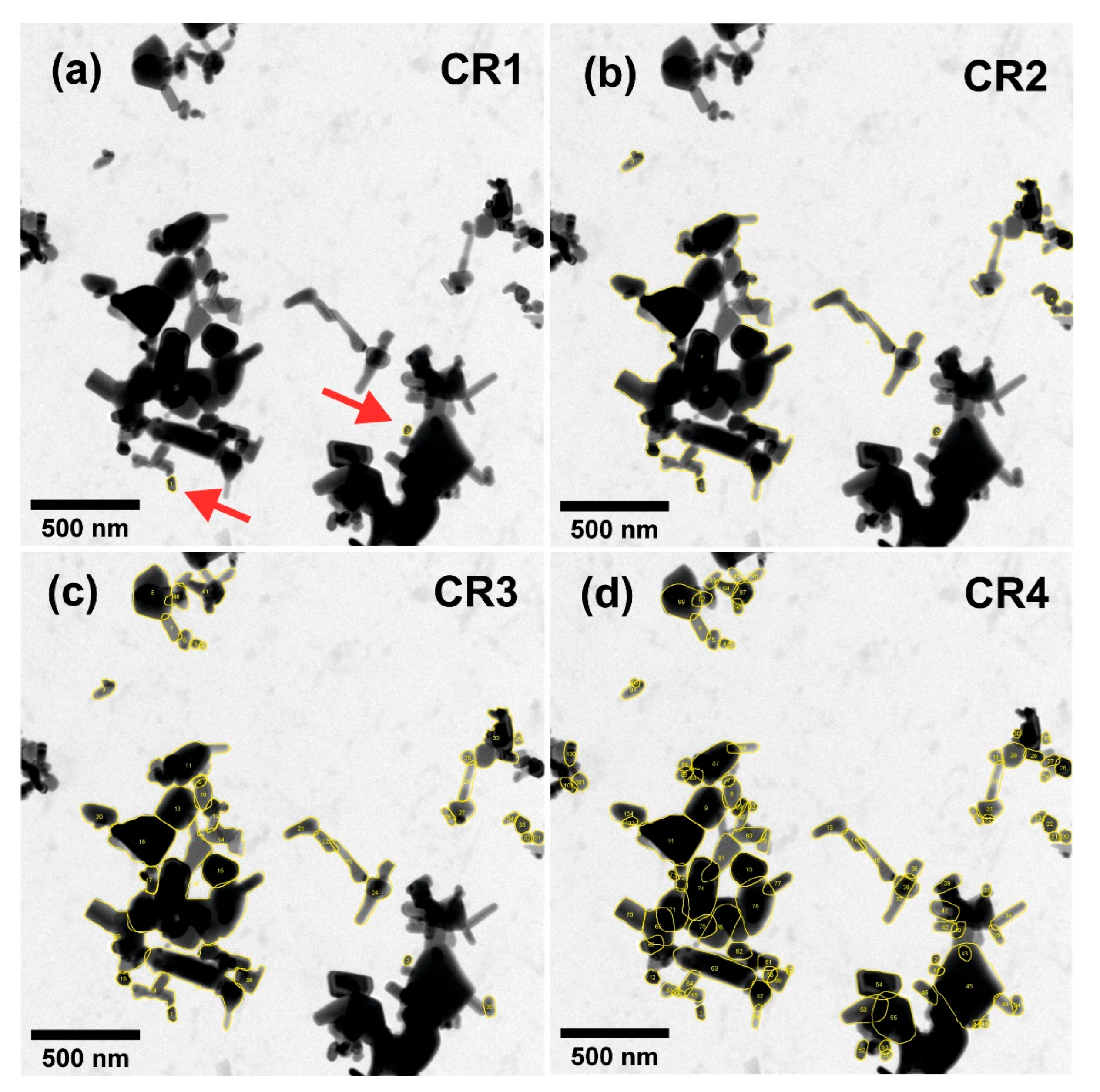
4.3. Small Agglomerates with Identifiable Integral Compounds
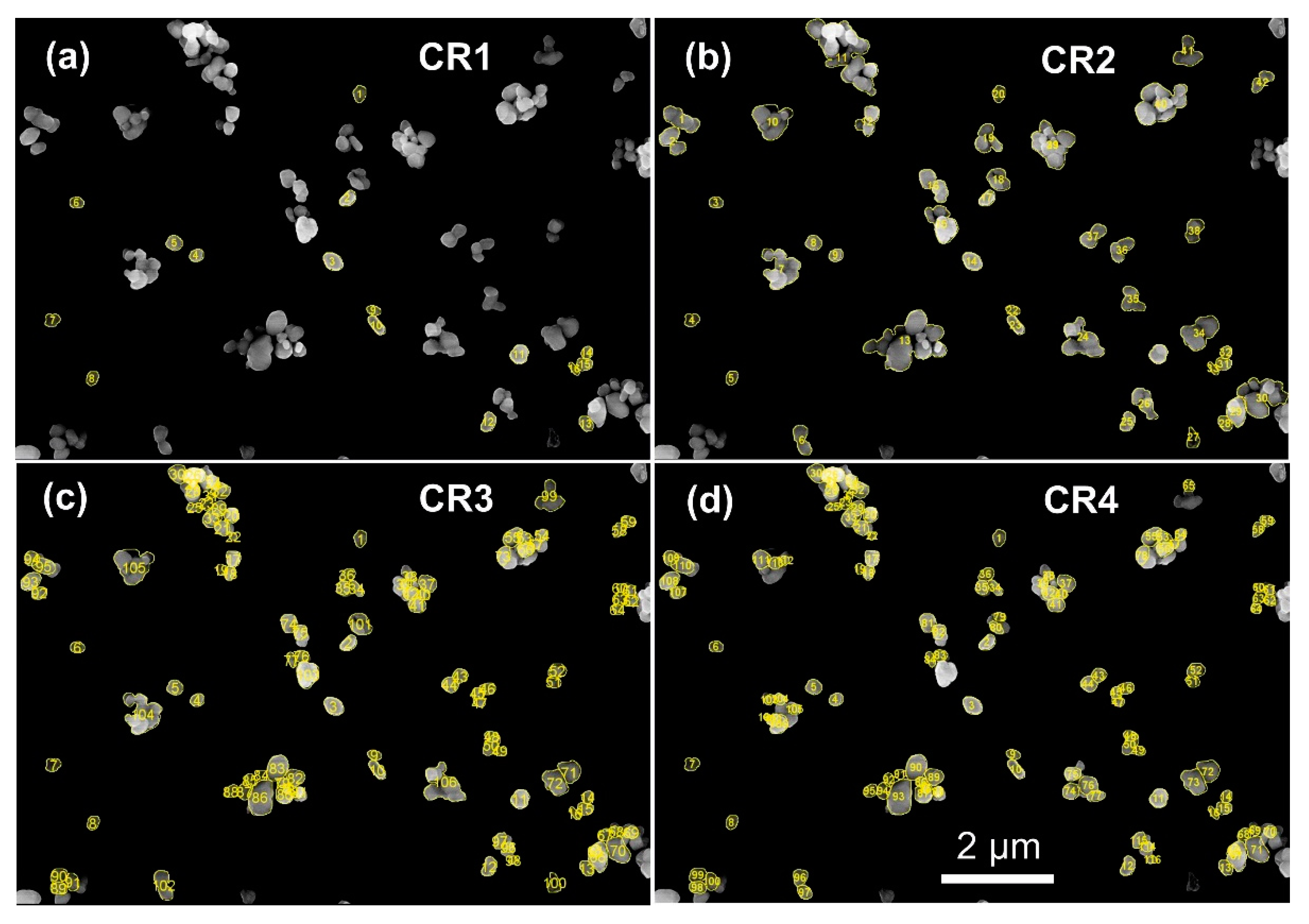
4.4. The Influence of EM Instrumentation and of the Specific Measurement Method
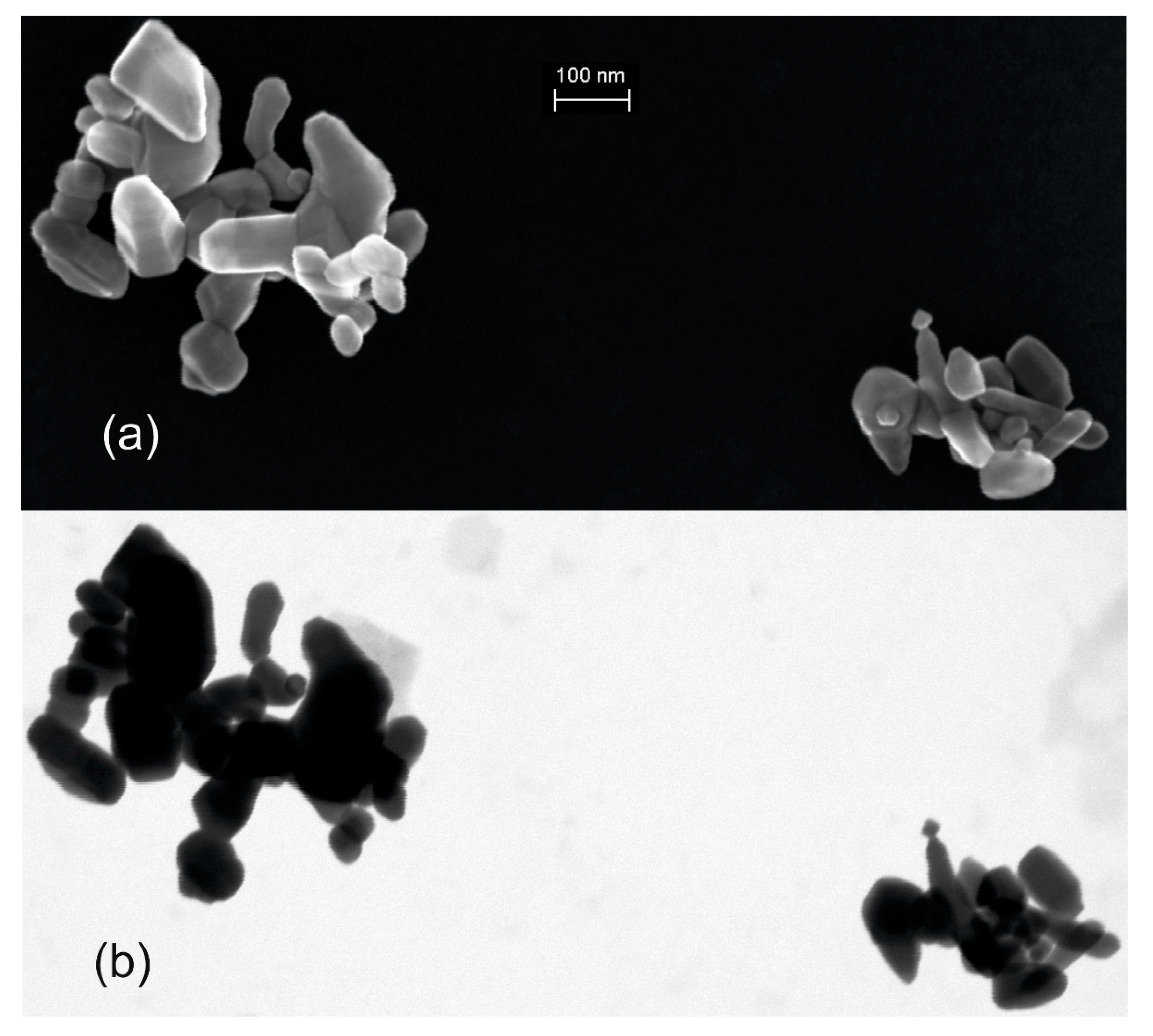
4.5. Beyond the Limits of EM
4.6. Proposed Procedure for a Reliable Counting of Small Particles
- (a)
- Identify the goal of the characterisation (quality control, registration in accordance with specific regulatory requirements, etc.).
- (b)
- Identify and name the relevant counting rule (e.g., CR1, CR2, CR3, CR4) in accordance with possible needs stated by the scientific community, standardisation (e.g., ISO) or legislation.
- (c)
- Identify and apply an appropriate dispersion protocol for the material and an appropriate protocol for the sample preparation. Be aware that the chosen protocol will influence the characteristics of the dispersion and thereby also lead to different results. An optimal and reproducible dispersion and sample preparation are crucial for reliable results.
- (d)
- Identify, measure and count all individual particles which are not bound to agglomerates or aggregates and are not overlapping.
- (e)
- Identify, measure and count all particles that are touching or overlapping but the borders can be identified with high confidence and accuracy (Examples see Section 4.2 and Section 4.3).
- (f)
- Overlapping particles where the borders cannot be identified with high confidence should be regarded as agglomerates and identified, measured and counted in accordance with the relevant counting rule.
- (g)
- Fused particles with inaccurate borders should be regarded as aggregates and identified, measured and counted as such in accordance with the relevant counting rule.
- (h)
- Where it is not possible to identify borders between the particles, this particle should be counted in accordance with the appropriate counting rule or excluded from the analysis.
5. Conclusions
Supplementary Materials
Author Contributions
Funding
Data Availability Statement
Acknowledgments
Conflicts of Interest
Disclaimer
References
- De Temmerman, P.-J.; Van Doren, E.; Verleysen, E.; Van der Stede, Y.; Francisco, M.A.D.; Mast, J. Quantitative characterization of agglomerates and aggregates of pyrogenic and precipitated amorphous silica nanomaterials by transmission electron microscopy. J. Nanobiotechnol. 2012, 10, 24. [Google Scholar] [CrossRef] [PubMed] [Green Version]
- Albers, P.; Maier, M.; Reisinger, M.; Hannebauer, B.; Weinand, R. Physical boundaries within aggregates—Differences between amorphous, para-crystalline, and crystalline Structures. Cryst. Res. Technol. 2015, 50, 846–865. [Google Scholar] [CrossRef]
- Grulke, E.A.; Yamamoto, K.; Kumagai, K.; Häusler, I.; Österle, W.; Ortel, E.; Hodoroaba, V.-D.; Brown, S.C.; Chan, C.; Zheng, J.; et al. Size and shape distributions of primary crystallites in titania aggregates. Adv. Powder Technol. 2017, 28, 1647–1659. [Google Scholar] [CrossRef] [PubMed] [Green Version]
- Verleysen, E.; Wagner, T.; Lipinski, H.-G.; Kägi, R.; Koeber, R.; Boix-Sanfeliu, A.; De Temmerman, P.-J.; Mast, J. Evaluation of a TEM based Approach for Size Measurement of Particulate (Nano)materials. Materials 2019, 12, 2274. [Google Scholar] [CrossRef] [Green Version]
- Rasmussen, K.; Rauscher, H.; Mech, A.; Riego Sintes, J.; Gilliland, D.; González, M.; Kearns, P.; Moss, K.; Visser, M.; Groenewold, M.; et al. Physico-chemical properties of manufactured nanomaterials—Characterisation and relevant methods. An outlook based on the OECD Testing Programme. Regul. Toxicol. Pharmacol. 2018, 92, 8–28. [Google Scholar] [CrossRef]
- Organisation for Economic Co-Operation and Development (OECD): Guidance Manual for the Testing of Manufactured Nanomaterials: OECD’s Sponsorship Programme; First Revision. ENV/JM/MONO(2009)20/REV. 2009. Available online: http://www.oecd.org/officialdocuments/publicdisplaydocumentpdf/?cote=env/jm/mono%282009%2920/rev&doclanguage=en (accessed on 20 June 2022).
- Babick, F.; Mielke, J.; Wohlleben, W.; Weigel, S.; Hodoroaba, V.-D. How reliably can a material be classified as a nanomaterial? Available particle-sizing techniques at work. J. Nanopart. Res. 2016, 18, 158. [Google Scholar] [CrossRef] [PubMed] [Green Version]
- Mech, A.; Rauscher, H.; Rasmussen, K.; Babick, F.; Hodoroaba, V.-D.; Ghanem, A.; Wohlleben, W.; Marvin, H.; Brungel, R.; Friedrich, C. The NanoDefine Methods Manual. Part 2: Evaluation of Methods, EUR 29876 EN; Publications Office of the European Union: Luxemburg, 2019; ISBN 978-92-76-11953-1. [Google Scholar] [CrossRef]
- Organisation for Economic Co-Operation and Development (OECD): Draft Test Guideline on Particle Size and Particle Size Distribution of Nanomaterials (PSD). 2022. Available online: https://www.oecd.org/chemicalsafety/testing/draft-test-guideline-particle-size-distribution-nanomaterials.pdf (accessed on 20 June 2022).
- Schmidt, A.; Bresch, H.; Kämpf, K.; Bachmann, V.; Peters, T.; Kuhlbusch, T. Development of a Specific OECD Test Guideline on Particle Size and Particle Size Distribution of Nanomaterials. German Environment Agency—Publications 2021, 161/2021. Available online: https://www.umweltbundesamt.de/sites/default/files/medien/479/publikationen/texte_161-2021_development_of_a_specific_oecd_test_guideline_on_particle_size_and_particle_size_distribution_of_nanomaterials.pdf (accessed on 20 June 2022).
- Regulation (EC) No 1907/2006 of the European Parliament and of the Council of 18 December 2006 Concerning the Registration, Evaluation, Authorisation and Restriction of Chemicals (REACH), Establishing a European Chemicals Agency, Amending Directive 1999/45/EC and Repealing Council Regulation (EEC) no 793/93 and Commission Regulation (EC) no 1488/94 as Well as Council Directive 76/769/EEC and Commission Directives 91/155/EEC, 93/67/EEC, 93/105/EC and 2000/21/EC; Off. J. Eur. Union L 396, 30.12.2006, 1–849. Available online: https://eur-lex.europa.eu/eli/reg/2006/1907/2014-04-10 (accessed on 20 June 2022).
- Regulation (EC) No 1223/2009 of the European Parliament and of the Council of 30 November 2009 on Cosmetic Products. Off. J. Eur. Union L 342, 22.12.2009, 59–209. Available online: https://eur-lex.europa.eu/eli/reg/2009/1223/oj (accessed on 20 June 2022).
- EFSA Scientific Committee; More, S.; Bampidis, V.; Benford, D.; Bragard, C.; Halldorsson, T.; Hernández-Jerez, A.; Bennekou, S.H.; Koutsoumanis, K.; Lambré, C.; et al. Guidance on risk assessment of nanomaterials to be applied in the food and feed chain: Human and animal health. EFSA J. 2021, 19, e06768. [Google Scholar] [CrossRef] [PubMed]
- U.S. Department of Health and Human Services, Office of the Commissioner, Office of Policy, Legislation, and International Affairs, Office of Policy: Guidance for Industry—Considering Whether an FDA-Regulated Product Involves the Application of Nanotechnology. 2014. Available online: http://www.fda.gov/RegulatoryInformation/Guidances/ucm257698.htm (accessed on 20 June 2022).
- U.S. Environmental Protection Agency (EPA): Chemical Substances When Manufactured or Processed as Nanoscale Materials; TSCA Reporting and Record keeping Requirements, 82 FR 22088-22089. Available online: https://www.govinfo.gov/content/pkg/FR-2017-05-12/pdf/2017-09683.pdf (accessed on 20 June 2022).
- European Commission: COMMISSION RECOMMENDATION of 18 October 2011 on the Definition of Nanomaterial 2011/696/EU. Off. J. Eur. Union 2011, L275/38. Available online: http://data.europa.eu/eli/reco/2011/696/oj (accessed on 20 June 2022).
- Regulation (EU) 2015/2283 of the European Parliament and of the Council of 25 November 2015 on Novel Foods, Amending Regulation (EU) No 1169/2011 of the European Parliament and of the Council and Repealing Regulation (EC) No 258/97 of the European Parliament and of the Council and Commission Regulation (EC) No 1852/2001. Off. J. Eur. Union L 327, 11.12.2015, 1–22. Available online: http://data.europa.eu/eli/reg/2015/2283/oj (accessed on 20 June 2022).
- Regulation (EU) No 528/2012 of the European Parliament and of the Council of 22 May 2012 Concerning the Making Available on the Market and Use of Biocidal Products. Off. J. Eur. Union L 167, 27.6.2012, 1–123. Available online: http://data.europa.eu/eli/reg/2012/528/oj (accessed on 20 June 2022).
- Regulation (EU) 2017/745 of the European Parliament and of the Council of 5 April 2017 on Medical Devices, Amending Directive 2001/83/EC, Regulation (EC) No 178/2002 and Regulation (EC) No 1223/2009 and Repealing Council Directives 90/385/EEC and 93/42/EEC. Off. J. Eur. Union L 117, 5.5.2017, 1–175. Available online: http://data.europa.eu/eli/reg/2017/745/oj (accessed on 20 June 2022).
- Rasmussen, K.; Sokull-Klüttgen, B.; Yu, I.J.; Kanno, J.; Hirose, A.; Gwinn, M.R. Regulation and legislation applicable to nanomaterials. In Adverse Effects of Engineered Nanomaterials: Exposure, Toxicology, and Impact on Human Health, 2nd ed.; Fadeel, B., Pietroiusti, A., Shvedova, A., Eds.; Academic Press: London, UK, 2017; pp. 159–188. ISBN 9780128091999. [Google Scholar]
- Allan, J.; Belz, S.; Hoeveler, A.; Hugas, M.; Okuda, H.; Patri, A.; Rauscher, H.; Silva, P.; Slikker, W.; Sokull-Kluettgen, B.; et al. Regulatory landscape of nanotechnology and nanoplastics from a global perspective. Regul. Toxicol. Pharmacol. 2021, 122, 104885. [Google Scholar] [CrossRef] [PubMed]
- Mech, A.; Rauscher, H.; Babick, F.; Hodoroaba, V.-D.; Ghanem, A.; Wohlleben, W.; Marvin, H.; Weigel, S.; Brüngel, R.; Friedrich, C.M.; et al. The NanoDefine Methods Manual; European Commission, Joint Research Centre, Publications Office of the European Union: Luxemburg, 2020. [Google Scholar] [CrossRef]
- Egerton, R.; Li, P.; Malac, M. Radiation damage in the TEM and SEM. Micron 2004, 35, 399–409. [Google Scholar] [CrossRef] [PubMed]
- International Organization for Standardization: Nanotechnologies—Measurements of Particle Size and Shape Distributions by Transmission Electron Microscopy (ISO 21363:2020). 2020. Available online: https://www.iso.org/standard/70762.html (accessed on 20 June 2022).
- International Organization for Standardization: Reference Materials—Guidance for Characterization and Assessment of Homogeneity and Stability (ISO Guide 35:2017). 2017. Available online: https://www.iso.org/standard/60281.html (accessed on 20 June 2022).
- ISO/TS 80004-2:2015; Nanotechnologies—Vocabulary—Part 2: Nano-Objects. International Organization for Standardization: Geneva, Switzerland, 2015. Available online: https://www.iso.org/standard/54440.html (accessed on 20 June 2022).
- Oxford English Dictionary. 2022. Available online: https://www.oed.com/ (accessed on 20 June 2022).
- Merriam Webster Dictionary. 2022. Available online: https://www.merriam-webster.com/dictionary/constituent (accessed on 20 June 2022).
- Rauscher, H.; Roebben, G.; Mech, A.; Gibson, N.; Kestens, V.; Linsinger, T.P.J.; Riego Sintes, J. An Overview of Concepts and Terms Used in the European Commission’s Definition of Nanomaterial; EUR 29647 EN; European Commission: Luxemburg, 2019; ISBN 978-92-79-99660-3. [Google Scholar] [CrossRef]
- Bennet, F.; Burr, L.; Schmid, D.; Hodoroaba, V.-D. Towards a method for quantitative evaluation of nanoparticle from suspensions via microarray printing and SEM analysis. J. Phys. Conf. Ser. 2021, 1953, 012002. [Google Scholar] [CrossRef]
- Michen, B.; Geers, C.; Vanhecke, D.; Endes, C.; Rothen-Rutishauser, B.; Balog, S.; Petri-Fink, A. Avoiding drying-artifacts in transmission electron microscopy: Characterizing the size and colloidal state of nanoparticles. Sci. Rep. 2015, 5, 9793. [Google Scholar] [CrossRef] [PubMed] [Green Version]
- ISO 14887:2000; Sample Preparation—Dispersing Procedures for Powders in Liquids. International Organization for Standardization: Geneva, Switzerland, 2000. Available online: https://www.iso.org/standard/25861.html (accessed on 20 June 2022).
- ISO 19749:2021; Nanotechnologies—Measurements of Particle Size and Shape Distributions by Scanning Electron Microscopy. International Organization for Standardization: Geneva, Switzerland, 2021. Available online: https://www.iso.org/standard/66235.html (accessed on 20 June 2022).
- EFSA Scientific Committee; More, S.; Bampidis, V.; Benford, D.; Bragard, C.; Halldorsson, T.; Hernández-Jerez, A.; Bennekou, S.H.; Koutsoumanis, K.; Lambré, C.; et al. Guidance on technical requirements for regulated food and feed product applications to establish the presence of small particles including nanoparticles. EFSA J. 2021, 19, e06769. [Google Scholar] [CrossRef] [PubMed]
- Vladár, A.E.; Hodoroaba, V.-D. Chapter 2.1.1—Characterization of nanoparticles by scanning electron microscopy. In Characterization of Nanoparticles; Hodoroaba, V.-D., Unger, W.E.S., Shard, A.G., Eds.; Micro and Nano Technologies; Elsevier: Amsterdam, The Netherlands, 2020; pp. 7–27. ISBN 978-0-12-814182-3. [Google Scholar]
- Klein, T.; Buhr, E.; Johnsen, K.-P.; Frase, C.G. Traceable measurement of nanoparticle size using a scanning electron microscope in transmission mode (TSEM). Meas. Sci. Technol. 2011, 22, 094002. [Google Scholar] [CrossRef]
- Hodoroaba, V.-D.; Motzkus, C.; Macé, T.; Vaslin-Reimann, S. Performance of High-Resolution SEM/EDX Systems Equipped with Transmission Mode (TSEM) for Imaging and Measurement of Size and Size Distribution of Spherical Nanoparticles. Microsc. Microanal. 2014, 20, 602–612. [Google Scholar] [CrossRef] [PubMed]
- Crouzier, L.; Delvallée, A.; Devoille, L.; Artous, S.; Saint-Antonin, F.; Feltin, N. Influence of electron landing energy on the measurement of the dimensional properties of nanoparticle populations imaged by SEM. Ultramicroscopy 2021, 226, 113300. [Google Scholar] [CrossRef]
- De Temmerman, P.-J.; Verleysen, E.; Lammertyn, J.; Mast, J. Semi-automatic size measurement of primary particles in aggregated nanomaterials by transmission electron microscopy. Powder Technol. 2014, 261, 191–200. [Google Scholar] [CrossRef]

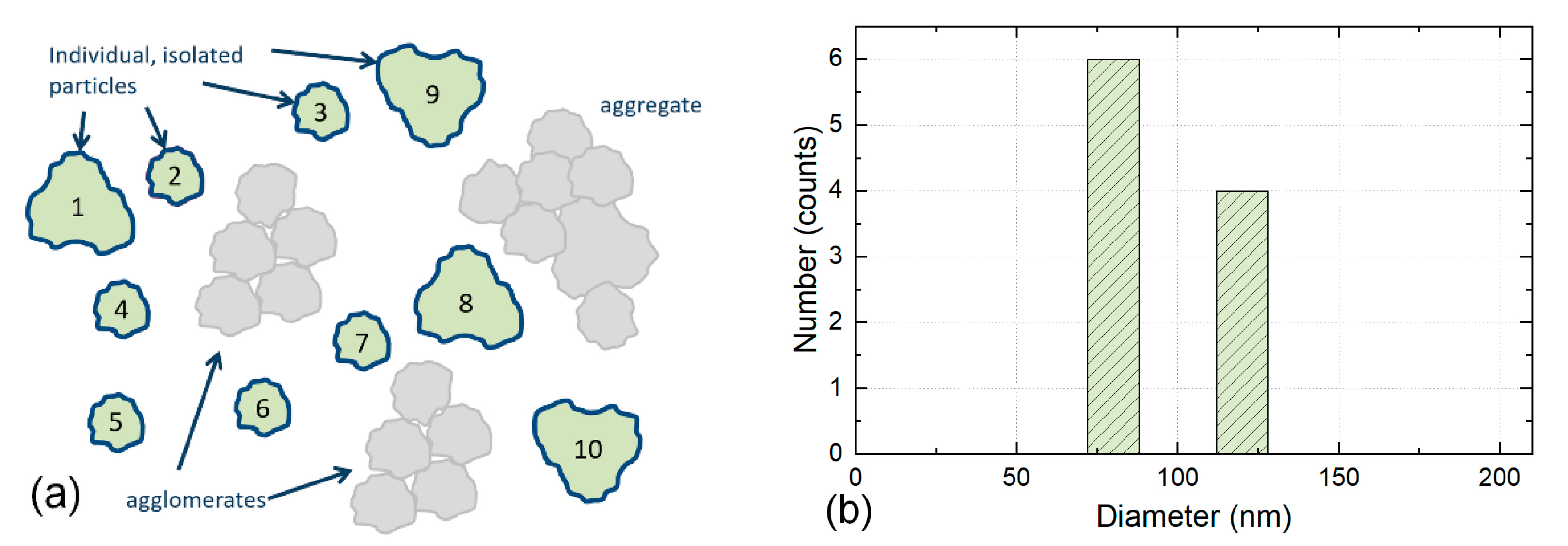
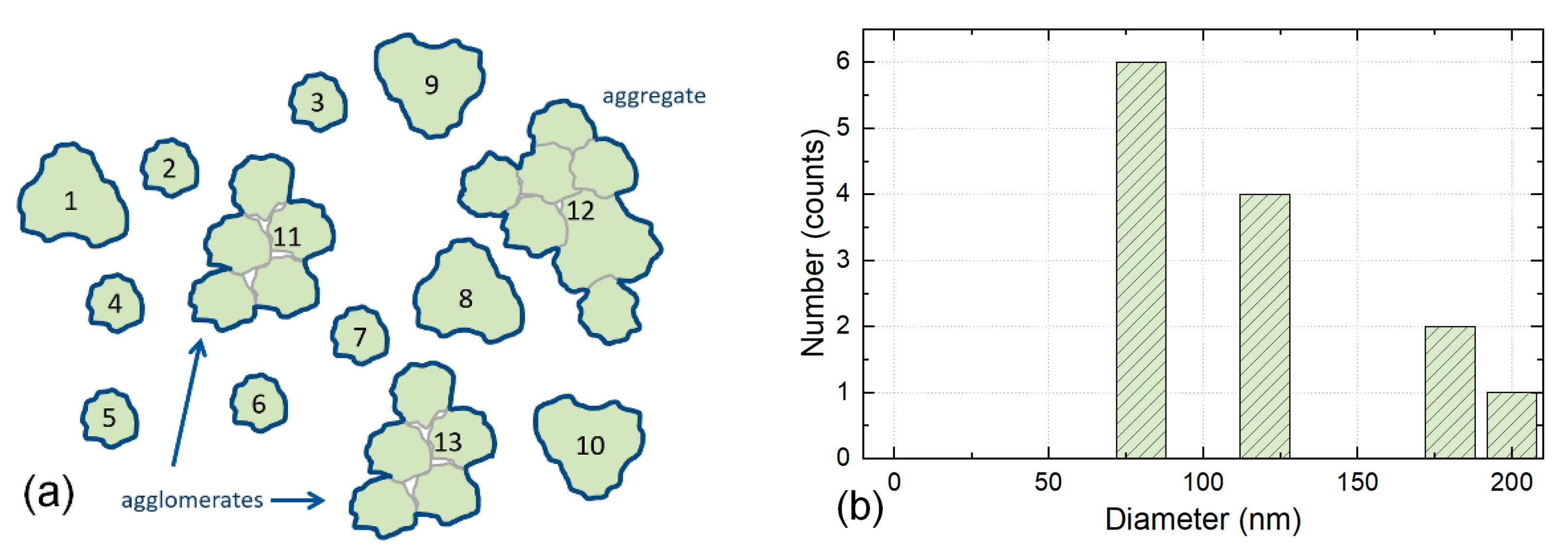
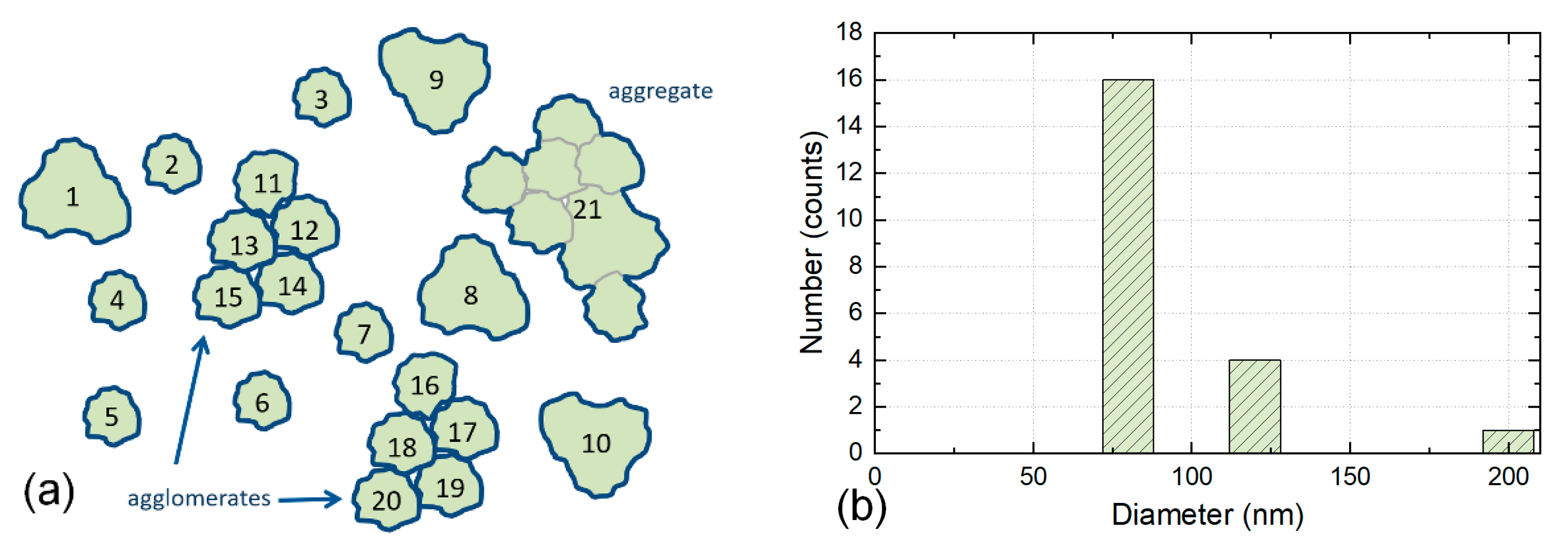
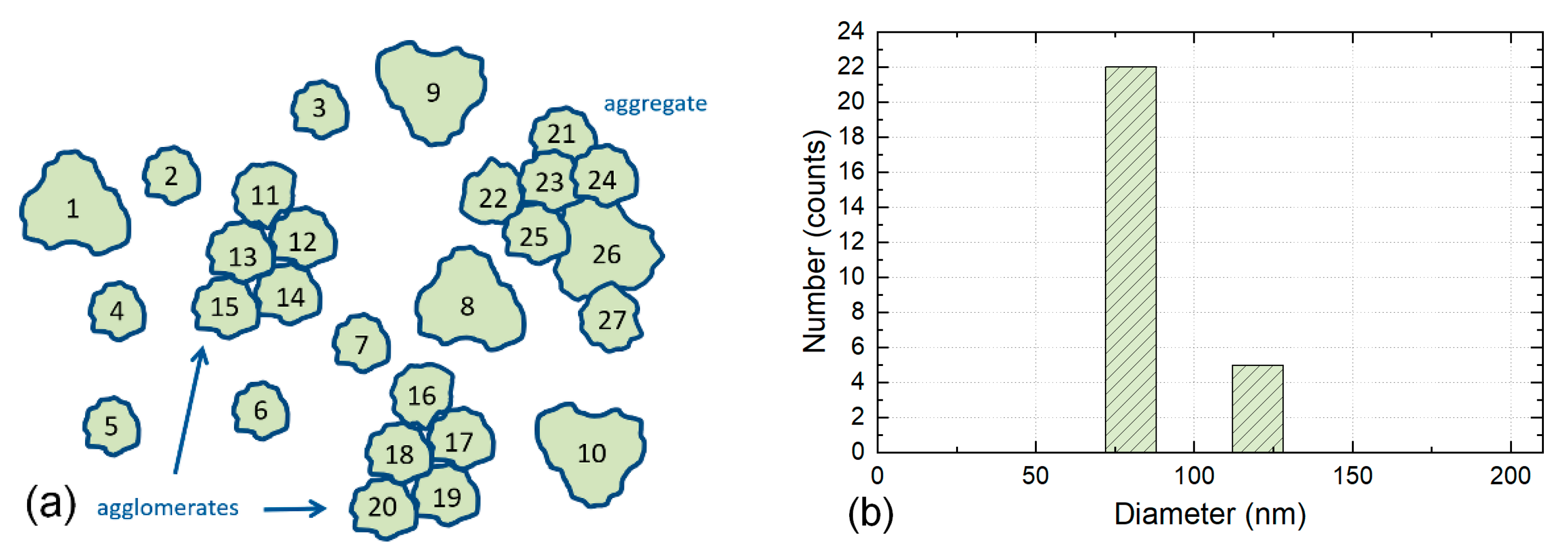

| Constituent Particle In order to understand the exact meaning of “constituent” in a specific context, the point of reference is crucial, i.e., the “unit” or “whole” to which it refers. | |
| ISO Definition | EC Definition |
| The point of reference are larger particles or “units”, such as agglomerates and aggregates. | The point of reference is the initial material, or “whole” material. |
| According to ISO 80004-2, a constituent particle is an “identifiable, integral component of a larger particle” [26]. | The EC definition describes the term nanomaterial: ” ‘nanomaterial’ … should be based solely on the size of the constituent particles of a material…” and continues further explaining what these constituent particles are: “ ’Nanomaterial’ means a … material containing particles, in an unbound state or as an aggregate or as an agglomerate…” [16]. |
| Accordingly, constituent particles are always part of a larger ensemble and can be aggregates themselves, which could form even larger agglomerates. | The term “constituent particle” refers to the entire material, so individual particles as well as the constituents of agglomerates and aggregates are considered constituent particles of a material. |
| CR | Total Number of Particles | No. of Particles of a Specific Size | |||
|---|---|---|---|---|---|
| 80 nm | 120 nm | 180 nm | 200 nm | ||
| CR1 | 10 | 6 | 4 | 0 | 0 |
| CR2 | 13 | 6 | 4 | 2 | 1 |
| CR3 | 21 | 16 | 4 | 0 | 1 |
| CR4 | 27 | 22 | 5 | 0 | 0 |
| dmean; dmedian; SD * (nm) | |||||
|---|---|---|---|---|---|
| Counting Rule | CR1 | CR2 | CR3 | CR4 | |
| Descriptor | |||||
| Minimum Feret diameter | 43; 43; ±1 | 255; 98; ±109 | 113; 85; ±13 | 73; 58; ±4 | |
| ECD ** | 52; 52; ±6 | 242; 126; ±105 | 127; 106; ±13 | 94; 78; ±5 | |
| Maximum Feret diameter | 64; 64; ±11 | 413; 215; ±166 | 182; 138; ±21 | 124; 99; ±7 | |
| Number of particles | 2 | 7 | 41 | 104 | |
Publisher’s Note: MDPI stays neutral with regard to jurisdictional claims in published maps and institutional affiliations. |
© 2022 by the authors. Licensee MDPI, Basel, Switzerland. This article is an open access article distributed under the terms and conditions of the Creative Commons Attribution (CC BY) license (https://creativecommons.org/licenses/by/4.0/).
Share and Cite
Bresch, H.; Hodoroaba, V.-D.; Schmidt, A.; Rasmussen, K.; Rauscher, H. Counting Small Particles in Electron Microscopy Images—Proposal for Rules and Their Application in Practice. Nanomaterials 2022, 12, 2238. https://doi.org/10.3390/nano12132238
Bresch H, Hodoroaba V-D, Schmidt A, Rasmussen K, Rauscher H. Counting Small Particles in Electron Microscopy Images—Proposal for Rules and Their Application in Practice. Nanomaterials. 2022; 12(13):2238. https://doi.org/10.3390/nano12132238
Chicago/Turabian StyleBresch, Harald, Vasile-Dan Hodoroaba, Alexandra Schmidt, Kirsten Rasmussen, and Hubert Rauscher. 2022. "Counting Small Particles in Electron Microscopy Images—Proposal for Rules and Their Application in Practice" Nanomaterials 12, no. 13: 2238. https://doi.org/10.3390/nano12132238
APA StyleBresch, H., Hodoroaba, V.-D., Schmidt, A., Rasmussen, K., & Rauscher, H. (2022). Counting Small Particles in Electron Microscopy Images—Proposal for Rules and Their Application in Practice. Nanomaterials, 12(13), 2238. https://doi.org/10.3390/nano12132238






